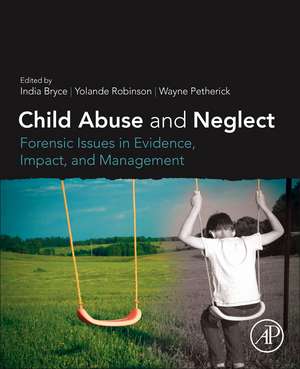Child Abuse and Neglect: Forensic Issues in Evidence, Impact and Management
Editat de India Bryce, Yolande Robinson, Wayne Pethericken Limba Engleză Paperback – 4 feb 2019
This book fills a void in the available university-level classroom-targeted literature, promoting the inclusion of child abuse as a standalone subject within university curricula. As such, readership includes undergraduate and postgraduate students, teachers and wider scholarship, as well as practitioners; including those from psychology, criminology, criminal justice and law enforcement.
- Presents an up-to-date approach that tackles child abuse from several viewpoints
- Includes typologies, risk and protective factors, recognition, responses, biopsychosocial outcomes, public policy, prevention, institutional abuse, children and corrections, treatment and management, and myths and fallacies
- Provides information on significant advances in knowledge areas, such as disclosure, the neurological effects of child abuse and neuroplasticity, and online and virtual child abuse
Preț: 505.73 lei
Preț vechi: 729.77 lei
-31% Nou
Puncte Express: 759
Preț estimativ în valută:
96.78€ • 105.09$ • 81.30£
96.78€ • 105.09$ • 81.30£
Carte tipărită la comandă
Livrare economică 16-30 aprilie
Preluare comenzi: 021 569.72.76
Specificații
ISBN-13: 9780128153444
ISBN-10: 012815344X
Pagini: 485
Dimensiuni: 191 x 235 mm
Greutate: 0.83 kg
Editura: ELSEVIER SCIENCE
ISBN-10: 012815344X
Pagini: 485
Dimensiuni: 191 x 235 mm
Greutate: 0.83 kg
Editura: ELSEVIER SCIENCE
Public țintă
Primary: Forensic Psychologists, Forensic Criminologists, and practitioners in Criminal Justice and Law Enforcement.Secondary: Students and Instructors of upper-level undergraduate and graduate level forensic psychology and criminology programs.
Cuprins
Part 1 Types of Child Abuse
1. Child Abuse: Types and Emergent Issues
2. Intimate partner violence as a form of child abuse
3. Keeping our eye on sex, power, relationships and institutional contexts in preventing Institutional Child Sexual Abuse
4. Online Child Sexual Abuse
5. Understanding Violent Extremism and Child Abuse: A Psychological Analysis
6. Child trafficking: characteristics, complexities and challenge
7. Gender comparisons of offenders: Males and females who sexually offend against children
Part 2 Impact and Outcomes of Child Abuse
8. Forensic Victimology Assessments in Child Abuse and Neglect Cases
9. Cumulative Harm: Chronicity, Re-victimisation and Developmental Victimology
10. The Pathological Consequences of Exposure to Domestic and Family Violence in Childhood
11. Physical punishment and offending in two successive generations
12. Physical discipline, child abuse and children’s rights
13. Understanding the nature and dimensions of child sexual abuse to inform its prevention
Part 3 Management: Responding to Child Abuse
14. False Reports in Child Abuse and Neglect Cases
15. Mandatory Reporting: Managing Disclosure and Information Gathering
16. Virtue Ethics and Good Professional Judgment in Statutory Child Protection
17. Decision making guidelines for the child protection intake phase
18. Eight Core Principles of Neurobiologically-Informed Interventions for Trauma form Childhood Maltreatment
19. Understanding childhood maltreatment and subsequent re-victimization: A Singapore perspective
20. Understanding child maltreatment across ethnic minority communities in Australia: physical abuse, neglect, witnessing domestic and family violence and child sexual abuse
21. Child abuse and neglect and the judicial system: the limits of legal enterprise
22. Public (mis)perceptions of sexual abusers of children and their implications thereof
1. Child Abuse: Types and Emergent Issues
2. Intimate partner violence as a form of child abuse
3. Keeping our eye on sex, power, relationships and institutional contexts in preventing Institutional Child Sexual Abuse
4. Online Child Sexual Abuse
5. Understanding Violent Extremism and Child Abuse: A Psychological Analysis
6. Child trafficking: characteristics, complexities and challenge
7. Gender comparisons of offenders: Males and females who sexually offend against children
Part 2 Impact and Outcomes of Child Abuse
8. Forensic Victimology Assessments in Child Abuse and Neglect Cases
9. Cumulative Harm: Chronicity, Re-victimisation and Developmental Victimology
10. The Pathological Consequences of Exposure to Domestic and Family Violence in Childhood
11. Physical punishment and offending in two successive generations
12. Physical discipline, child abuse and children’s rights
13. Understanding the nature and dimensions of child sexual abuse to inform its prevention
Part 3 Management: Responding to Child Abuse
14. False Reports in Child Abuse and Neglect Cases
15. Mandatory Reporting: Managing Disclosure and Information Gathering
16. Virtue Ethics and Good Professional Judgment in Statutory Child Protection
17. Decision making guidelines for the child protection intake phase
18. Eight Core Principles of Neurobiologically-Informed Interventions for Trauma form Childhood Maltreatment
19. Understanding childhood maltreatment and subsequent re-victimization: A Singapore perspective
20. Understanding child maltreatment across ethnic minority communities in Australia: physical abuse, neglect, witnessing domestic and family violence and child sexual abuse
21. Child abuse and neglect and the judicial system: the limits of legal enterprise
22. Public (mis)perceptions of sexual abusers of children and their implications thereof
